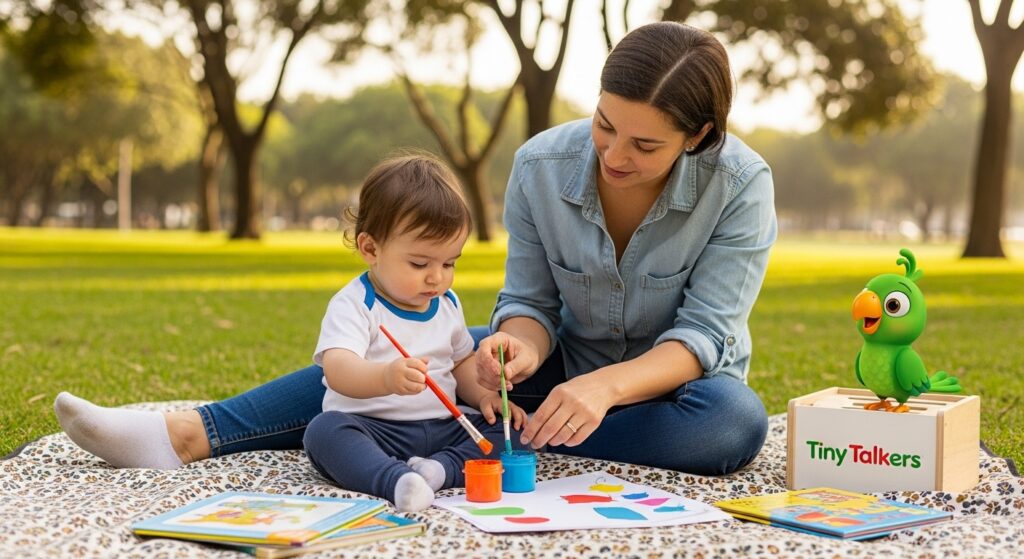Engaging in arts and crafts activities is not only a fantastic way to ignite creativity in toddlers, but it’s also a powerful tool for enhancing their language development. As a parent, you might wonder how crafting can influence language skills. Well, when children participate in these artistic endeavors, they are exposed to a variety of opportunities to expand their vocabulary, improve their communication skills, and boost their confidence in expressing themselves.
The Connection Between Arts and Crafts and Language Development
Arts and crafts activities provide a rich sensory experience that stimulates different areas of the brain, including those involved in language processing. When toddlers engage in these activities, they encounter new words, learn to follow instructions, and develop storytelling skills—all of which are crucial components of language development.
Vocabulary Expansion
One of the most straightforward ways crafting can enhance language skills is through vocabulary expansion. As you introduce your toddler to different materials like clay, paint, or fabric, you naturally introduce new words. Describing colors, shapes, textures, and actions helps children build a more extensive vocabulary.
- Use descriptive language: Encourage your toddler to touch and feel different materials while you describe them using rich, descriptive language. For example, “This felt is soft and fuzzy,” or “The paint is smooth and cold.”
- Name the tools: Introduce the names of crafting tools such as scissors, glue, or paintbrushes, and explain their purposes. This not only improves vocabulary but also enhances their understanding of their surroundings.
Enhancing Communication Skills
Crafting is a social activity, often done alongside parents, siblings, or peers. These interactions provide the perfect setting for toddlers to practice their communication skills.
- Encourage conversation: While crafting, engage in conversations about what your child is making. Ask open-ended questions like, “What are you creating today?” or “Can you tell me about your drawing?”
- Practice listening and responding: Encourage your toddler to listen to instructions and respond appropriately. This helps them understand the give-and-take nature of communication.
Storytelling and Imagination
Arts and crafts can inspire storytelling, a vital component of language development. As toddlers create, they begin to narrate their thoughts and ideas, which boosts their storytelling skills and imagination.
- Create stories together: After crafting, ask your child to tell you a story about their creation. Prompt them with questions like, “Who lives in this painted house?” or “What adventure will this character go on?”
- Encourage creativity: Allow your child the freedom to express themselves without restrictions. This encourages them to think creatively and articulate their thoughts.
Choosing the Right Arts and Crafts Activities
Selecting age-appropriate arts and crafts activities is essential to ensure your toddler remains engaged and benefits from the experience. Here are some suggestions for activities that promote language development:
Collage Making
Collage making is a fantastic activity that allows toddlers to explore different textures and materials. As they select and arrange items, they learn new words associated with those objects.
- Introduce themed collages: Choose themes like “Under the Sea” or “Forest Adventure” and discuss the related vocabulary. This thematic approach makes learning new words fun and relevant.
- Encourage storytelling: After completing the collage, ask your toddler to tell a story about the scene they have created.
Playdough Sculpting
Playing with playdough is not only fun but also beneficial for language development. As toddlers mold different shapes, they learn new words and improve their ability to follow instructions.
- Shape and object identification: Encourage your toddler to create specific shapes or objects, then discuss their creations. This helps them learn the names and characteristics of different items.
- Interactive play: Join your child in playdough sculpting and model language by describing what you’re doing. For instance, “I’m rolling the dough to make a long, thin snake.”
Painting and Drawing
Painting and drawing allow toddlers to express themselves visually, while also offering a platform to practice language skills.
- Discuss the process: Talk with your toddler about the colors they are using and the images they are creating. Ask questions that encourage them to describe their artwork.
- Introduce new concepts: Use drawing sessions to introduce concepts like “light” and “dark” or “big” and “small,” enhancing their understanding of these terms.
Storybook Crafting
Creating storybooks is a wonderful way to combine crafting with language learning. As toddlers illustrate and narrate their own stories, they develop reading and writing skills alongside verbal communication.
- Encourage sequencing: Help your child understand the sequence of events by asking them to arrange their story in order. This boosts comprehension and organizational skills.
- Share and read aloud: Once the storybook is complete, encourage your toddler to share their story with family members, reinforcing their confidence in speaking.
Tips for Maximizing Language Development During Arts and Crafts
To make the most of these activities, consider the following tips:
- Be patient and supportive: Allow your toddler to explore and learn at their own pace. Celebrate their efforts, regardless of the outcome.
- Limit distractions: Create a calm environment where your child can focus on their activity and the accompanying language learning.
- Encourage repetition: Repeating activities helps reinforce new vocabulary and concepts, solidifying their learning experience.
Conclusion
Integrating arts and crafts into your toddler’s routine is a delightful way to enhance their language development in a natural, engaging manner. These activities not only expand vocabulary and improve communication skills but also foster imagination and creativity. By providing a supportive and interactive crafting environment, you’re setting the stage for your child’s successful language acquisition. Remember, the journey is as important as the destination, so enjoy these precious moments of learning and creativity together.

